Minimizing the concentration of CO2 in the atmosphere is one of the most critical challenges of our time. A promising technology for mitigating climate change is CO2 capture and utilization.
The easiest way to do this is in industrial processes, where CO2 accumulates in large quantities as waste gas.
For the conversion of this concentrated CO2 into value products, GIG Karasek is developing a pilot plant consisting of an electrochemical reactor cell and associated peripherals as its core.
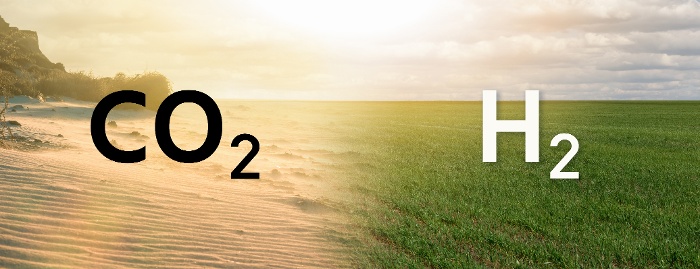
Year after year, questionable increase in CO2 emissions
CO2 emissions are the primary driver of global climate change. Around 35 trillion metric tons of CO2 were emitted worldwide in 2020. The EU-27 accounted for 2.6 trillion tons (Europe excl. EU-27: 2.35 trillion tons, Germany: 644 million tons, Austria: 60 million tons).
The resulting complex consequences will significantly impact society, ecosystems, and the economy in the coming decades
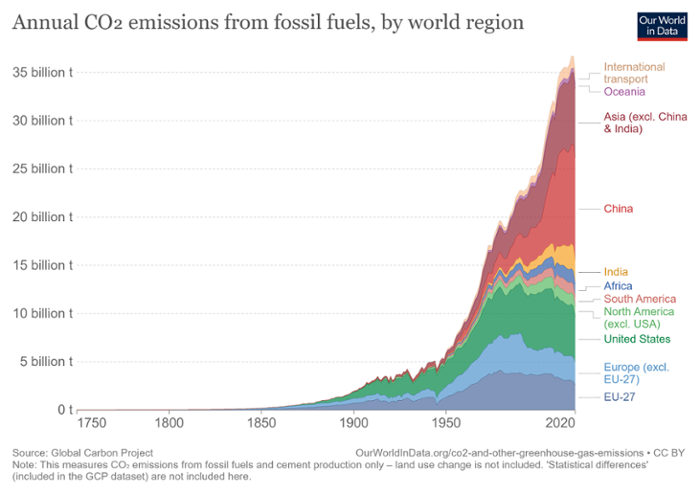
The cost of climate change for companies
The consequences of climate change for companies are diverse. On the one hand, extreme weather phenomena can damage production sites, cause shortfalls in supply or create disruptions in the supply chain. On the other hand, new technologies, markets, and legal regulations are emerging in the course of societal changes, resulting in additional expenses or directly impacting existing products, services, and assets. In particular, escalating CO2 prices are putting companies under increasing pressure
CO2 certificates at an all-time high
Europe introduced the European Emissions Trading Scheme (EU ETS) for CO2 taxation back in 2008. As a result, all significant electricity and heat producers and industrial plants such as steel mills, chemical plants, energy producers, or cement plants must purchase CO2 certificates.
The price of traded CO2 certificates has tripled over 2021 and is currently just under 94 euros (as of 3.2.2022). The high demand for certificates is the high gas prices, which causes electricity producers to switch to coal-fired power generation. A significant part of the price increase is also due to political reforms, to meet the European climate targets.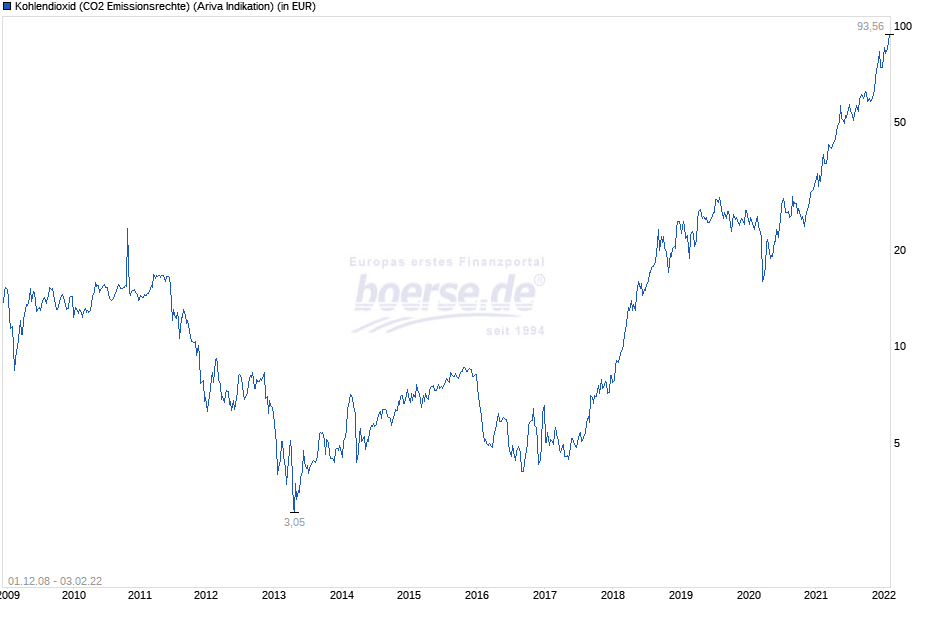
Source: CO2 Emission rights, boerse.de
Energy-intensive industries are the key to decarbonization
Large parts of the industries in Europe are already contributing to climate protection in various ways. The focus is primarily on increasing energy efficiency and the increased use of renewable energies. However, these measures alone will not be enough to achieve the climate targets of the "Green Deal.“
In order to minimize the adverse effects of climate change and its costs, comprehensive solutions are necessary concerning CO2 management in companies. Therefore, the energy-intensive industry is significant, playing a decisive role in decarbonizing other sectors. Moreover, if basic materials are manufactured in a climate-neutral manner, this will also reduce the CO2 imprint of downstream sectors of the economy.
In addition, basic chemical materials, steel, and cement are essential for expanding renewable energies. Competitive technologies for decarbonizing production processes in these sectors, in particular, are indispensable in the future. Last but not least, the revision of the European emissions trading system and rising CO2 prices will also have a significant impact.
CO2 Utilization as a sustainable model for the future
Fossil hydrocarbons as raw materials and energy suppliers are indispensable for many industries. The energy factor determines as much as 75 percent of the manufacturing costs of various products. With rising CO2 prices, the production costs of energy-intensive industries, in particular, will inevitably rise.
Moreover, if crude oil is no longer processed in refineries in the course of decarbonization, there will be a shortage of petrochemicals. Primary products such as ethylene and methane and all secondary products will gradually become scarce (see Chemical/Refinery Flowchart).In addition, industries such as cement, iron and steel, aluminum, pulp and paper, and refineries inevitably generate CO2 emissions, resulting from energy-intensive industrial processes.
A future-oriented, problem-solving technology is the capture, utilization, and storage of CO2. In this process, CO2 is collected precisely where it is first emitted. It can then either be processed into valuable products or stored permanently.
A pilot plant from GIG Karasek, under development with Johannes Kepler University Linz (JKU Linz), will soon demonstrate how its innovative technology can work.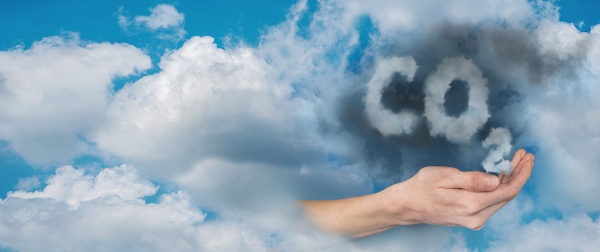
Pilot plant for CO2 Utilization with innovative catalysts
JKU Linz and GIG Karasek initiated the project to make a sustainable contribution to reducing global CO2 emissions. The objective is to recycle CO2 through electrochemical reduction into basic chemicals such as CO, formic acid, acetic acid, and fuels such as hydrogen, methane, methanol, and ethanol.
Apart from the development of novel catalysts, the research cooperation of this project includes planning the construction of a pilot plant for testing and optimizing the process solution. The first plant with several cells connected in series should be ready for industrial use by the end of 2023. The pilot plant will, in turn, provide the basis for the design and dimensioning of large-scale industrial plants. A market launch will then be possible based on this scale-up concept.
Green, profitable process plant solution through "Dream Reaction“
CO2 utilization is achieved by the so-called "Dream Reaction" with the help of a specially designed electrocatalyst and a suitable reactor cell. The electrical energy required for the conversion is supplied from renewable energy sources, enabling a fully sustainable and climate-friendly cycle.
Chemists refer to a reaction in which a product is made from low-cost building blocks as a "dream reaction " in a one-step process. Therefore, valuable materials can be produced in a much more energy-efficient way using the catalytic cycle. Hydrogen, for example, can be generated directly, whereas, in other processes, it has to be produced in a further, energy-intensive step.
However, the reactor cell with an integrated catalyst alone is not enough to establish the technology. The decisive factor is optimum integration into the surrounding periphery to ensure the most energy-efficient and clean operation possible. The reactor cell forms the core, but it must be made operational in the overall system in terms of application technology.
Waste becomes fuel, plastics, and basic chemicals
A CO2 reduction plant is applicable in many industrial sectors, e.g., to utilize CO2 in flue gas from industrial plants. The following sketch illustrates the overall process of CO2 capture and utilization using flue gas as an example:
- Flue gas is fed into the reactor cell, powered by green energy, and converted.
- The resulting product stream contains many components and must then be separated, distilled, and concentrated.
- The end product is hydrogen, ethanol, methane, and other high-carbon compounds. They can be processed into plastics or stored as fuels and transported for further use as needed.
- By-products include chemical feedstocks such as formic acid, acetic acid, and a variety of other chemicals that can be sold on the market at high prices.
With this technology, companies can convert millions of tons of CO2 per year into high-quality chemical products that can be directly reused in industrial processes or used to manufacture a wide range of products. Companies using such process solutions will thus reduce their CO2 emissions and benefit from marketable products.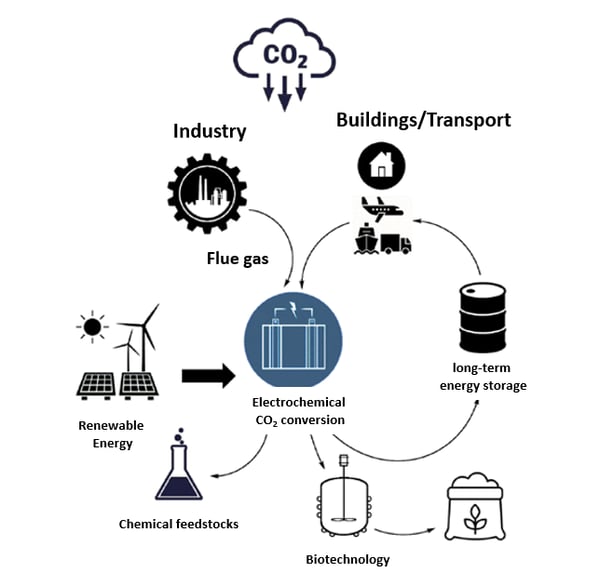 © JKU Linz
© JKU Linz
CO2 Utilization for the storage of renewable energies
Electrochemical CO2 utilization can also be a possible solution for storing fluctuating renewable energies. Surplus wind or solar energy that cannot be fed directly into the power grid and used could be converted electrochemically into methanol, for example.
Under ideal conditions, the conversion of 1 ton of CO2 equivalents could store nearly 1,400 kWh of energy. When needed, the methanol can then be used again, for example, as fuel in a direct methanol/ethanol fuel cell (DMFC).
Outlook: Prices for CO2 emission rights will rise
The European Emissions Trading Scheme (EU ETS) is a crucial mechanism through which the EU intends to reduce net greenhouse gas emissions by 55 percent, by 2030 compared to 1990 levels.
However, with the revision of the Revision des EU-EHS as part of the "Fit for 55" package, other industries are to be included, and free allowances will gradually phase out. Therefore, it can be expected that CO2 prices will rise much more dramatically in the future and that there is an urgent need for action for CO2 intensive industries.
Fit for 55: EU to phase out free certificates
Currently, free certificates are issued to prevent industrial companies from moving to countries with less stringent emission restrictions (carbon leakage).
In future, the EU intends to give less leeway in this regard: The proposals of the EU Commission, known as the "Fit for 55" package, aim to reduce the number of free permits for specific industries and to reduce the number of permits in circulation each year faster than is currently the case.
As early as 2025, the EU wants to significantly reduce the number of free certificates and introduce a marginal tax on CO2. Similarly, the phasing out of emission allowances for energy-intensive industries by 2036 is foreseen. As a result, the shortage in the supply of CO2 certificates will significantly impact prices.
Austria: CO2 tax from 1.7.2022
To increase the price of fossil fuels and promote climate-friendly alternatives, many European countries already have CO2 taxes. For example, Austria's National Emission Allowance Trading Act 2022 will also introduce a price on CO2 emissions that are not already subject to the EU ETS.
Primarily affected are gasoline, diesel, heating oil, natural gas, liquefied petroleum gas, coal, and kerosene. In the fixed-price phase from July 2022 to 2025, CO2 prices per metric ton will be set. As of July 2022, the price will rise from 30 euros per metric ton to 55 euros per metric ton in 2025. From 2026, the price will then be calculated by an emissions trading system.
Conclusion: CO2 Utilization for economization and recovery
Innovative technologies promote competition and open up new market opportunities. Companies that use process solutions to capture and recycle CO2 will save costs by reducing CO2 emissions and generating profits with marketable products. With CO2 taxes on the rise, return on investment (ROI) is expected to occur sooner rather than later. In addition, process solutions such as these form the basis for affordable, profitable, and environmentally friendly solutions for generations to come.



